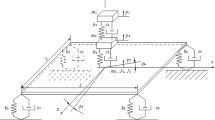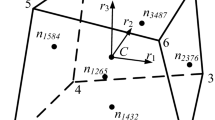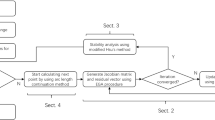Abstract
Multi-parameter sensitivity algorithms can be used to construct a Hessian matrix and second-degree Taylor expansion. In terms of an asymmetric dynamic system, two multi-parameter sensitivity algorithms are proposed in this paper. The modal method with its consistence proof is firstly derived to compute the first- and second-order sensitivities of the eigenpair, and the algebraic method with its stability proof is also proposed. One significant difference between the algebraic method and the modal method is that the algebraic method uses the derivative of the normalization condition as the bordered equation to remove the singularity of the coefficient matrix in the sensitivity dominant equation, whereas the modal method uses the derivative of the normalization condition as the supplementary equation to determine the special coefficient in the modal superposition for a normalized undamped mode shape. As both the proposed methods adopt the same normalization condition, the resulting sensitivities are consistent with each other. Three numerical example are used to determine the correctness, accuracy and validity of the proposed methods in three cases: a single-parameter system, a two-parameter system, and a special system which has complex eigenpairs caused by the asymmetric property of the dynamic system.

Similar content being viewed by others
References
Machado MR, Adhikari S, Dos Santos JMC, Arruda JRF (2018) Estimation of beam material random field properties via sensitivity-based model updating using experimental frequency response functions. Mech Syst Signal Process 102:180–197
Hansen JB, Brincker R, López-Aenlle M, Overgaard CF, Kloborg K (2017) A new scenario-based approach to damage detection using operational modal parameter estimates. Mech Syst Signal Process 94:359–373
Fu YZ, Lu ZR, Liu JK (2013) Damage identification in plates using finite element model updating in time domain. J Sound Vib 332:7018–7032
Jaishi B, Ren WX (2006) Damage detection by finite element model updating using modal flexibility residual. J Sound Vib 290:369–387
Jia HP, Beom HG, Wang YX, Lin S, Liu B (2011) Evolutionary level set method for structural topology optimization. Comput Struct 89:445–454
Kundu A, Matthies HG, Friswell MI (2018) Probabilistic optimization of engineering system with prescribed target design in a reduced parameter space. Comput Methods Appl Mech Eng 337:281–304
Bogomolni M, Kirsch U, Sheinman I (2006) Efficient design sensitivities of structures subjected to dynamic loading. Int J Solids Struct 43:5485–5550
Weng S, Tian W, Zhu HP, Xia Y, Gao F, Zhang YT, Li JJ (2017) Dynamic condensation approach to calculation of structural responses and response sensitivities. Mech Syst Signal Process 88:302–317
Rogers LC (1973) Derivatives of eigenvalues and eigenvectors. AIAA J 11:1191–1194
Murthy DV, Haftka RT (1988) Derivatives of eigenvalues and eigenvectors of a general complex matrix. Int J Numer Methods Eng 26:293–311
Plaut RH, Huseyin K (1973) Derivative of eigenvalues and eigenvectors in non-self adjoint systems. AIAA J 11:250–251
Juang JN, Ghaemmaghami P, Lim KB (1989) Eigenvalue and eigenvector derivatives of a nondefective matrix. J Guid 12:480–486
Zhao YQ, Liu ZS, Chen SH, Zhang GY (1999) An accurate modal truncation method for eigenvector derivatives. Comput Struct 73:609–614
Garg S (1973) Derivatives of eigensolutions for a general matrix. AIAA J 11:1191–1194
Rudisill CS (1974) Derivatives of eigenvalues and eigenvectors for a general matrix. AIAA J 12:721–722
Rudisill CS, Chu YY (1975) Numerical methods for evaluating the derivatives of eigenvalues and eigenvectors. AIAA J 13:834–837
Nelson RB (1976) Simplified calculation of eigenvector derivatives. AIAA J 14:1201–1205
Tan RCE, Andrew AL (1989) Computing derivatives of eigenvalues and eigenvectors by simultaneous iteration. IMA J Numer Anal 9:111–122
Tan RCE (1989) Some acceleration methods for iterative computation of derivatives of eigenvalues and eigenvectors. Int J Numer Methods Eng 28:1505–1519
Andrew AL, Tan RCE (2000) Iterative computation of derivatives of repeated eigenvalues and the corresponding eigenvectors. Numer Linear Algebr Appl 7:151–167
Wang PX, Dai H (2016) Eigensensitivity of symmetric damped systems with repeated eigenvalues by generalized inverse. J Eng Math 96:201–210
Lee IW, Kim DO, Jung GH (1999) Natural frequency and mode shape sensitivities of damped systems: Part II. Multiple natural frequencies. J Sound Vib 223:413–424
Acknowledgements
This work was supported by the Natural Science Foundation of Jilin Province of China [grant numbers 20190201028JC].
Author information
Authors and Affiliations
Corresponding author
Additional information
Publisher's Note
Springer Nature remains neutral with regard to jurisdictional claims in published maps and institutional affiliations.
Rights and permissions
About this article
Cite this article
Zhang, M., Yu, L. & Zhang, W. Algebraic and modal methods for computing high-order sensitivities in asymmetrical undamped system. J Eng Math 122, 59–79 (2020). https://doi.org/10.1007/s10665-020-10046-7
Received:
Accepted:
Published:
Issue Date:
DOI: https://doi.org/10.1007/s10665-020-10046-7




